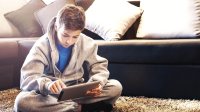Confronting the Abominable Snow Day
Using digital tools to keep students on track even when they can’t get to school.
Your content has been saved!
Go to My Saved Content.Here in the Pacific Northwest, we recently had our 10th snow day of the school year. We had four before Christmas, and when the fifth arrived before the exam period, bringing a forecast of more to come, our school decided we needed to move quickly to keep students on track for exams and the rest of the year.
So what to do? In a last-ditch effort to continue the momentum of learning and help our students prepare for exams, our school developed a Digital Learning Day (DLD) protocol. (We encourage you to create your protocol before you need it.) Here’s how our plan worked.
Digital Learning Day Protocol
To start with, teachers posted instructions and virtual office hours for the day by 10 a.m. on our learning management system (we use Schoology). Learning activities were posted for all classes, not just those missed on that day, and those learning activities were expected to last about 30 minutes per class period. Finally, those students who experienced power outages or internet disruptions were not penalized for being unable to complete the work; they simply continued to study with their regular course materials.
We crossed our fingers and hoped . . . and we were blown away by the results. Analytics from Schoology revealed that students and faculty accessed their pages as frequently and for as long as they would during a normal school day.
Student and parent feedback was positive and constructive. Students asked to have a deliverable to motivate them to get the work done, and some students even advocated for offering a regular DLD before every exam period.
Luckily or not, more snow days followed after our exam review period, so we created what we called Protocol B, designed to replace a regular school day.
Once again, teachers posted instructions and virtual office hours for the day by 10 a.m. on Schoology, but this time, DLD activities were limited to the classes being missed on that day. The learning activities for each class were expected to last between 45 and 60 minutes per class period, and students were required to submit a deliverable in each class to demonstrate completion of the work. The parents of students who experienced power outages or internet disruptions were required to notify the school of that fact as soon as possible.
Recipe for Success
Based on these experiences, our recipe for implementing a successful DLD calls for four basic ingredients: a digital learning platform, access to devices, learning objectives, and a clearly communicated, proactive protocol developed by faculty and administration.
In our case, being one-to-one (with one iPad per student) and having Schoology already in place smoothed the transition to a DLD. But equipment aside, the most critical ingredient of any school day—digital or otherwise—is the learning objective. And this is what makes the DLD format so exciting. As teachers, we found that when we created our DLD objectives, we were free to distill our intentions for the day, asking, “What does meaningful learning look like?” The resounding answer was: not busy work. Here are some examples of DLD activities that our teachers implemented:
- World language students created two-minute films or photo collages of their snow day activities, narrated in their world language. Students shared their pieces on Schoology and received feedback from each other and their teacher in the world language.
- Biology and digital literacy students prepared for their finals by using Padlet to post questions, answers, and visual resources that were then available to all students in all sections of those subjects.
- English and math students conferred with their teachers via FaceTime and Google Hangouts.
- Physical education and dance students posted their own instructional videos on Schoology.
- Teachers from all disciplines converted the day’s essential course content into short videos using iMovie, Keynote, PowerPoint, Explain Everything, and the recording tools on their devices.
Food for Thought
Although a DLD requires access to digital options, it does not require a one-to-one environment. As long as teachers and students have the ability to communicate through some kind of digital platform, a DLD is possible. Even a smartphone can be a powerful tool.
Here are a couple of tips for creating an ad hoc DLD. Set up a social media hashtag and have students use it when they post, which will enable you to easily search their responses. Take advantage of the huge number of useful videos on YouTube. You can use Remind (which works as a website, app, or texting service) to communicate and share materials with students. Or try curating a collection of links and resources to share with students through Pinterest, eduClipper, or Pocket. More simply, if you use a teacher web page, you can post instructions and share resources there.
If all else fails, you can always email with your students. Anything to get the job done.
Even if you can’t host a DLD for students, don’t miss the chance to have a DLD for yourself. Take the time to try the tools you’ve been meaning to try, create a flipped lesson, or start the YouTube channel you dreamed of creating. No matter what, snow days don’t have to be abominable anymore.
